
Papilio demoleus is a common and widespread swallowtail butterfly. The butterfly is also known as the lime butterfly, lemon butterfly, lime swallowtail, and chequered swallowtail. These common names refer to their host plants, which are usually citrus species such as the cultivated lime. Unlike most swallowtail butterflies, it does not have a prominent tail. The butterfly is a pest and invasive species, found from Asia to Australia. The butterfly has spread to Hispaniola island in the Western Hemisphere, and to Mahé, Seychelles.
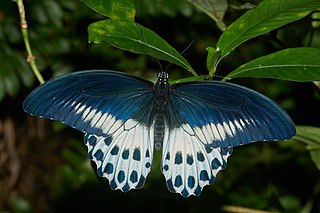
Papilio polymnestor, the blue Mormon, is a large swallowtail butterfly found in south India and Sri Lanka. It is the "state butterfly" of the Indian state of Maharashtra. With a wingspan of 120–150 mm, it is the fourth largest butterfly of India.

Thomas Dietmar Pöck is an Austrian former professional ice hockey defenceman. He played in the National Hockey League with the New York Rangers and the New York Islanders.
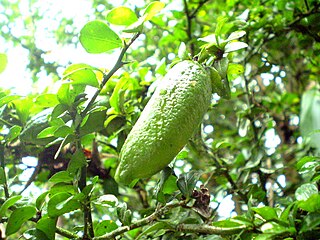
Citrus australasica, the Australian finger lime or caviar lime, is a thorny understorey shrub or small tree of lowland subtropical rainforest and rainforest in the coastal border region of Queensland and New South Wales, Australia.

The giant swallowtail is the largest butterfly in North America. It is abundant through many parts of eastern North America; populations from western North America and down into Panama are now considered to belong to a different species, Papilio rumiko. Though it is often valued in gardens for its striking appearance, its larval stage can be a serious pest to citrus farms, which has earned its caterpillars the names orange dog or orange puppy. The giant swallowtail caterpillars possess remarkable camouflage from predators by closely resembling bird droppings. They use this, along with their osmeteria, to defend against predators such as wasps, flies, and vertebrates.

Papilio aegeus, the orchard swallowtail butterfly or large citrus butterfly is a species of butterfly from the family Papilionidae, that is found in eastern Australia and Papua New Guinea.
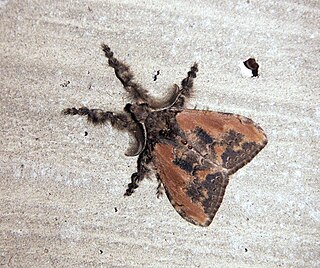
Olene mendosa, the brown tussock moth or hairy tussock moth, is a moth of the family Erebidae. The species was first described by Jacob Hübner in 1823. It is found in India, Bangladesh, Sri Lanka, Indonesia, Taiwan, Thailand and Australia.

Citrus × sinensis, also known as the sweet oranges, is a commonly cultivated family of oranges that includes blood oranges and navel oranges.

Pholodes sinistraria, the sinister moth or frilled bark moth, is a moth of the family Geometridae. The species was first described by Achille Guenée in 1857. It is found in the eastern parts of Australia.
Prays citri, the citrus blossom moth or citrus young fruit borer, is a moth of the family Praydidae. It is found in Southern Europe. There are reports of D. citri in other regions, but these are likely to be misidentifications of other Prays species: P. endocarpa in the Indian subcontinent and southeast Asia, P. endolemma in the Philippines and P. nepholemima in Borneo and Australasia.

Prays is a genus of moths of the family Praydidae, formerly assigned to Plutellidae or Yponomeutidae.
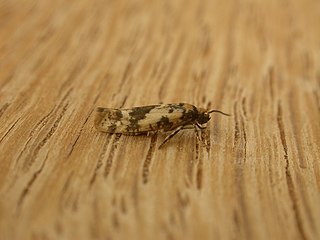
Prays parilis, the lemon bud moth, is a moth of the family Plutellidae. The species was first described by Alfred Jefferis Turner in 1923. It is found in Australia, New Zealand and the Cook Islands.
Indarbela quadrinotata, the bark-eating caterpillar, is a moth in the family Cossidae. It is found in India and Sri Lanka. It was described by Francis Walker in 1856.
The Bang Mot tangerine is a local cultivar of the mandarin orange grown in the Bang Mot area of Thon Buri, Bangkok, Thailand. Despite its common name, it is a mandarin orange of the species Citrus reticulata and not a tangerine. In 1924, a local farmer brought cuttings from a mandarin grove in Bangkok Noi District and planted them at Bang Mot, Thung Khru District near Bang Mot canal in 1924. This area has very fertile soil with elevated levels of potassium giving the fruit a sweet-sour taste. There were up to 96 square kilometres (37 sq mi) of tangerine groves in the past.
Suana concolor is a moth of the family Lasiocampidae first described by Francis Walker in 1855. It is found in India and Sri Lanka, to South China, Java, Borneo and the Philippines.
Euproctis fraterna is a moth of the family Erebidae first described by Frederic Moore in 1883. It is found in the Maldives, India, Sri Lanka and the Seychelles.
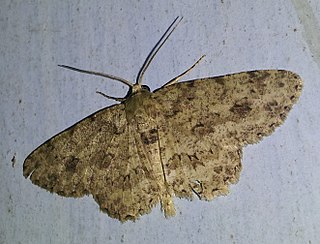
Ectropis bhurmitra, the tea twig caterpillar, is a moth of the family Geometridae. The species was first described by Francis Walker in 1860. A widespread Asian species, it is found around Indo-Australian tropics from India, Sri Lanka and Hong Kong, Taiwan, Thailand, New Guinea to Australian Queensland and the Solomon Islands.
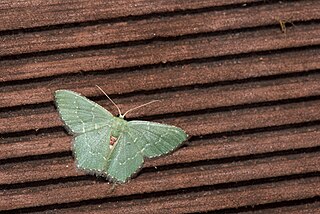
Hemithea marina is a moth of the family Geometridae first described by Arthur Gardiner Butler in 1878. It is found in the Indian subregion, Sri Lanka to Japan, Sundaland, Taiwan, Sulawesi and Seram.
Macroplectra nararia, the coconut slug caterpillar, is a moth of the family Limacodidae. The species was first described by Frederic Moore in 1859. It is found in Sri Lanka and India.

Xanthodes transversa, the transverse moth or hibiscus caterpillar, is a moth of the family Nolidae. The species was first described by Achille Guenée in 1852. It is found in India, Sri Lanka, the Andaman Islands, the Nicobar Islands, China, Hong Kong, Vanuatu, Java, New Guinea, Japan, the Ryukyu Islands, Singapore, Indonesia and Australia.













